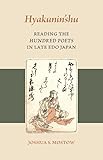Hyakunin’shu : Reading the Hundred Poets in Late Edo Japan / Joshua S. Mostow.
Material type: TextPublisher: Honolulu : University of Hawaii Press, [2024]Copyright date: 2024Description: 1 online resource (176 p.) : 123 b&w illustrations; 8 color illustrationsContent type:
TextPublisher: Honolulu : University of Hawaii Press, [2024]Copyright date: 2024Description: 1 online resource (176 p.) : 123 b&w illustrations; 8 color illustrationsContent type: - 9780824895686
- 9780824897796
- Japanese poetry -- Edo period, 1600-1868 -- History and criticism
- Japanese poetry -- To 1600 -- Translations into English
- Japanese poetry -- To 1600 -- History and criticism
- Waka -- History and criticism
- POETRY / Asian / Japanese
- Edo Art
- Edo Japan
- Hundred Poets
- Japan Art
- Japan Poets
- Japan Printmaking
- Japan history
- 895.61009 23/eng/20240110
- PL728.5.O4 H93 2024
- online - DeGruyter
| Item type | Current library | Call number | URL | Status | Notes | Barcode | |
|---|---|---|---|---|---|---|---|
 eBook
eBook
|
Biblioteca "Angelicum" Pont. Univ. S.Tommaso d'Aquino Nuvola online | online - DeGruyter (Browse shelf(Opens below)) | Online access | Not for loan (Accesso limitato) | Accesso per gli utenti autorizzati / Access for authorized users | (dgr)9780824897796 |
Browsing Biblioteca "Angelicum" Pont. Univ. S.Tommaso d'Aquino shelves, Shelving location: Nuvola online Close shelf browser (Hides shelf browser)

|

|

|

|

|

|

|
||
| online - DeGruyter Poems and Stories for Overcoming Idleness : P’ahan chip by Yi Illo / | online - DeGruyter Alternative Politics in Contemporary Japan : New Directions in Social Movements / | online - DeGruyter Chasing Traces : History and Ethnography in the Uplands of Socialist Asia / | online - DeGruyter Hyakunin’shu : Reading the Hundred Poets in Late Edo Japan / | online - DeGruyter Tattoo Traditions of Asia : Ancient and Contemporary Expressions of Identity / | online - DeGruyter Confronting Christianity : The Protestant Mission and the Buddhist Reform Movement in Nineteenth-Century Thailand / | online - DeGruyter Finding Home, a Hawaiian Petrel’s Journey / |
Frontmatter -- CONTENTS -- ACKNOWLEDGMENTS -- Introduction -- THE AUSPICIOUS JEWELS. One Hundred Poets, One Poem Each -- BIBLIOGRAPHY -- INDEX OF POETS AND FIRST LINES -- SUBJECT INDEX -- ABOUT THE AUTHOR
restricted access online access with authorization star
http://purl.org/coar/access_right/c_16ec
Hyakunin’shu: Reading the Hundred Poets in Late Edo Japan explores the “popular literary literacy” of the Japanese at the edge of modernity. By reproducing and translating a well-known annotated and illustrated Ansei-era (1854–1859) edition of the Hyakunin isshu—for hundreds of years the most basic and best-known waka primer in the entire Japanese literary canon—Joshua Mostow reveals how commoners of the time made sense of the collection. Thanks to the popularization of the poems in the early modern period and the advent of commercial publishing, the Hyakunin’shu (as it was commonly called) was no longer the exclusive intellectual property of the upper classes but part of a poetic heritage shared by all literate Japanese. Mostow traces the Hyakunin’shu’s history from the first published collections in the early sixteenth century and printed commentaries of formerly esoteric and secret exegesis to later editions that include imagined portraits of the poets and, ultimately, pictures of the “heart”—pictorializations of the meaning of the poems themselves. His study illuminates the importance of “variant One Hundred Poets,” such as the Warrior One Hundred Poets, in popularizing the collection and the work’s strong association with feminine education from the early eighteenth century onward. The National Learning (Kokugaku) movement pursued a philological analysis of the poems, leading to translations of the Hyakunin’shu into contemporary, vernacular, spoken Japanese. The poems eventually served as the basis of a card game that became a staple of New Year festivities. This volume presents some innovations in translating premodern Japanese poetry: in the Introduction, Mostow considers the Hyakunin’shu’s reception during the Edo, when male homoerotic relationships were taken for granted, and makes the case for his translating the love poems in a non-heteronormative way. In addition, the translated poems are lineated to give readers a sense of the original edition’s chirashi-gaki, or “scattered writing,” allowing them to see how each poem’s sematic elements are distributed on the page.
Mode of access: Internet via World Wide Web.
In English.
Description based on online resource; title from PDF title page (publisher's Web site, viewed 20. Nov 2024)


